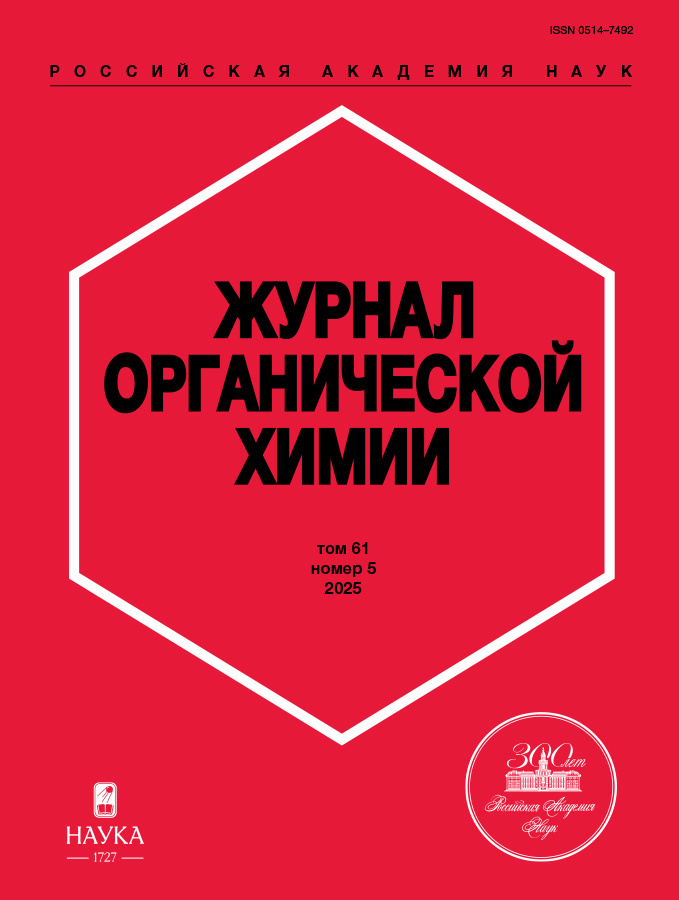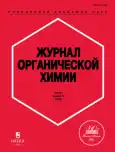Žurnal organičeskoj himii
ISSN (print): 0514-7492
Media registration certificate: No. FS 77 - 67135 dated 09/16/2016
Founder: Russian Academy of Sciences
Editor-in-Chief: Beletskaya Irina Petrovna
Number of issues per year: 12
Indexation: RISC, list of Higher Attestation Commissions, CrossRef, White List (level 3)
Russian Journal of Organic Chemistry is an international peer-reviewed journal that covers all aspects of modern organic chemistry including organic synthesis, theoretical organic chemistry, structure and mechanism, and the application of organometallic compounds in organic synthesis. The journal welcomes manuscripts from all countries.
Current Issue
Vol 61, No 5 (2025)
ЭКСПЕРИМЕНТАЛЬНЫЕ СТАТЬИ
Synthesis of bicyclo[2.2.1]heptane derivatives via one-pot three-component coupling of norbornene with aryl halide and arylacetylene using “ligand-free” pd catalytic systems
Abstract
The results of Pd-catalyzed difunctionalization of norbornene via one-pot three-component coupling of norbornene, aryl halide and arylacetylene with new C(sp3)−C(sp2)/C(sp3) −C(sp) bond formation are presented. The convenience of the proposed approach compared to other methods is the use of a simple and accessible “ligand-free” catalytic system based on palladium salts and an inorganic base to obtain valuable bicyclo[2.2.1]heptane derivatives.
Žurnal organičeskoj himii. 2025;61(5):517-525
 517-525
517-525


5-Arylpyrrolidine-2-carboxylic acid derivatives as precursors in the synthesis of sulfonyl-substituted pyrroles
Abstract
cis-5-Arylpyrrolidine-2-carboxylates obtained in 1,3-dipolar cycloaddition reactions from arylaldimines of glycine and vinyl sulfones go through oxidative aromatization under the action of manganese(IV) oxide to the 5-aryl-2-pyrrolecarboxylates in high yield. Factors affecting the retention of the sulfonyl substituent in the pyrrole molecule have been established.
Žurnal organičeskoj himii. 2025;61(5):526-537
 526-537
526-537


Cyclopropyl-allyl rearrangement gem-dibromocyclopropanes under the action of aluminum carbenoides
Abstract
It was found for the first time that 2,3-dialkyl-substituted gem-dibromocyclopropanes react with a solution of aluminum carbenoid Me2AlCH2I in CH2Cl2 to give substituted bromoalkenes in good yield. The reaction is sensitive both to the nature of the organoaluminum Lewis acid and to the nature of the substitution of gem-dibromocyclopropane. A theoretical cyclopropyl-allyl rearrangement has been developed. The B3LYP/6-31G(d) method was used to calculate the free activation energies of the cyclopropyl-allyl rearrangement step for a number of gem-dibromocyclopropanes and aluminum-containing Lewis acids.
Žurnal organičeskoj himii. 2025;61(5):538-543
 538-543
538-543


Cyclocondensation of methyl 5-methyl-1-(2-oxo-2-phenylethyl)-1H-pyrazole-3-carboxylate as a method for constructing a new 18-member nitrogenic macroheterocycle
Abstract
A method for the synthesis of a new 18-m embered nitrogen macroheterocycle was developed. It was based on the acid-catalytic cyclocondensation of 1-[(2E,Z)-2-hydrazono-2-phenylethyl]-5-methyl-1H-pyrazole-3-carbohydrazide, a reaction product of methyl 5-methyl-1-(2- oxo-2-phenylethyl)-1H-pyrazole-3-carboxylate with hydrazine.
Žurnal organičeskoj himii. 2025;61(5):544-551
 544-551
544-551


The Reaction of Dinitrofluoroacetonitrile with Substituted Nitrile N-Oxides
Abstract
The reaction of dinitrofluoroacetonitrile with nitrile N-oxides leads to 3-aryl(methyl)-5-dinitrofluoromethyl-1,2,4-oxadiazoles. The interaction of 1,2,4-oxadiazoles with an alcohol solution of potassium hydroxide is accompanied by the elimination of the dinitrofluoromethyl group and leads to 3-aryl(methyl)-5-hydroxy-1,2,4-oxadiazoles and the potassium salt of aci-dinitrofluoromethane.
Žurnal organičeskoj himii. 2025;61(5):552-556
 552-556
552-556


Oxidation Reactions of Cage Derivatives of Quinopimaric Acid
Abstract
Oxidation reactions of cage derivatives of quinopimaric acid – γ-diketone, oxa-“bird cage”, 18-chloro-15-oxa-“bird cage”, and 16-sulfanyl-15-oxa-“bird cage” were studied using a number of oxidizing agents: sodium percarbonate in trifluoroacetic acid at 0°C; 36% hydrogen peroxide in acetone at room temperature; tertiary butyl hydroperoxide in the presence of MoCl5 at boiling in benzene. It has been shown for the first time that the oxidation reactions of diterpene oxa-“bird cages” lead to the formation of a mixture of ketolactones (Bayer–Villiger reaction products) with a predominance of mainly 7,10-dioxo-6-oxahepta-cyclo[11.8.0.03,8.04,12.05,11.09,13.016,21]henicosan.
Žurnal organičeskoj himii. 2025;61(5):557-565
 557-565
557-565


Method for Synthesis of (±)-Entecavir
Abstract
Starting from (±)-lactonediol Corey, a practical route for the synthesis of (±)-Entecavir was developed, the key step of which is the preparation of (1R*,3R*,4S*)-4-(1-ethoxyethoxy)-3-[(1-ethoxyethoxy) methyl]-2-methylenecyclopentanol by oxidative decarboxylation of {(1S*,2R*,3S*,5R*)-5-{[tert-butyl(dimethyl)silyl]oxy}-3-(1-ethoxyethoxy)-2-[(1-ethoxyethoxy)methyl]cyclopentyl}acetic acid with lead tetraacetate.
Žurnal organičeskoj himii. 2025;61(5):566-571
 566-571
566-571


SYNTHESIS, ANTIMICROBIAL ACTIVITY, AND MOLECULAR DOCKING OF N-PHENYLCARBAMATE DERIVATIVES WITH A HETEROCYCLIC MOIETY
Abstract
By condensing o-phenylenediamine with 2(4)-aminobenzoic acids in 65% polyphosphoric acid at a temperature of 180–190°C for 4 h or by boiling the reagents in o-xylene in the presence of tetrabutoxytitanium, 2-(2(4)-aminophenyl)benzimidazoles were obtained, the acylation of which with methyl chloroformate in the presence of triethylamine led to the production of the corresponding benzimidazoles with a carbamate function. Condensation of o-phenylenediamine and 4-nitro-o-phenylenediamine with glycolic acid in the presence of 70–75% polyphosphoric acid with heating for four hours at 130°C yielded 2-hydroxymethylbenzimidazole with a yield of 81% and 5-nitro-2-hydroxymethylbenzimidazole with a yield of 84%, which, when treated with phenyl isocyanate in tetrahydrofuran at 27–30°C for 3.5 h, were converted into the corresponding benzimidazole derivatives with a yield of 84–86%. In order to find the most promising ones for further biological research, molecular docking of synthesized 2-substituted benzimidazoles, as well as previously obtained carbamate derivatives of pyridazine and N-allyl derivatives of 2-morpholinoethyl-N-phenylcarbamate and 2-(2-pyridinyl)ethyl-N-phenylcarbamate was carried out based on interaction with the enzyme glucosamine-6-phosphate synthase.
Žurnal organičeskoj himii. 2025;61(5):572-584
 572-584
572-584


SYNTHESIS OF IONIC LIQUIDS BASED ON N-(AMINOPOPYL)IMIDAZOLIUM CATIONS
Abstract
Three-component reaction between 1-(3-aminopropyl)imidazole, (iodomethyl)ketones and elemental iodine proceeds at room temperature without solvents to afford N-(aminopropyl)-imidazolium cations-derived triiodides. The target products are identified and characterized by NMR and UV techniques.
Žurnal organičeskoj himii. 2025;61(5):585-590
 585-590
585-590


SYNTHESIS OF 6(PYRROLYL)-AZOLO[1,5-A]PYRIMIDINE-7-AMINES BY THE CLAUSION–KAAS METHOD
Abstract
In this work, the synthesis of pyrrole derivatives based on azolo[1,5-a]pyrimidines (AP) using the Clauson–Kaas methodology is reported for the first time. It was found that within the series of azolo[1,5-a]- pyrimidine-6,7-diamines, the amino group at the 6-position reacts selectively. The developed method enables the synthesis of 6-(pyrrolyl)-[1,2,4]-azolo[1,5-a]pyrimidine-7-amines with yields of 64–85% and a high degree of purity. The reaction pathway is confirmed by NMR spectroscopy and X-ray structural analysis. The obtained results significantly expand the scope of azolopyrimidine modifications, opening new prospects for the targeted synthesis of functionalized derivatives.
Žurnal organičeskoj himii. 2025;61(5):591-600
 591-600
591-600


Synthesis and optical properties of 6-alkylamino-2-amino-4-(4-(dimethylamino)phenyl)-pyridine-3,5-dicarbonitriles
Abstract
6-Alkylamino-2-amino-4-(4-(dimethylamino)phenyl)pyridine-3,5-dicarbonitriles were obtained by the reaction of primary and secondary amines with 2-amino-6-chloro-4-(4-(dimethylamino)phenyl)pyridine-3,5-dicarbonitrile synthesized by three stages from dimethylaniline. The study of the spectral-luminescent properties showed the presence of fluorescence in solutions with a maximum in the region of 432–473 nm and a quantum yield of up to 29.5%, and in the solid state with a maximum in the region of 446–472 nm.
Žurnal organičeskoj himii. 2025;61(5):601-607
 601-607
601-607


Synthesis of benzo[b][1,4]oxazine adducts of c60 fullerene in the presence of lead(IV) acetate
Abstract
A method was developed for the synthesis of fused benzo[b][1.4]oxazine monoadducts of С60 fullerene in reactions with aminophenols (2-aminophenol, 2-amino-4-methylphenol, 2-amino-4-phenylphenol) in the presence of LiOH and Pb(OAc)4. A probable mechanism for the reactions of obtaining condensed benzo[b][1,4]oxazine adducts has been proposed.
Žurnal organičeskoj himii. 2025;61(5):608-613
 608-613
608-613


Synthesis and antimicrobial activity of unsaturated ketones with the furan fragment
Abstract
The methods for the synthesis of unsaturated ketones of the furan series based on the reaction of aldol-crotonic condensation of furfurol with some unsaturated ketones have been developed. It was found that among the used methods, the most optimal are the reactions in a medium of alcoholic solution of NaOH at room temperature, which pass more regioselectively with the formation of unsaturated ketones with high yields (65–75%), in this case the formation of side products is excluded. The availability of the synthesized unsaturated ketones of double bond and ketogroup in the molecule makes them perspective substrates in the synthesis of a number of various potentially biologically active compounds. In particular, it has been shown that the unsaturated ketones undergo the reaction with hydrazine-hydrate, thiosemicarbazide and secondary amines with the formation of the corresponding new furane derivatives.
Žurnal organičeskoj himii. 2025;61(5):614-620
 614-620
614-620


Synthesis and properties of new derivatives of 3-benzylspiro[benzo[h]quinazoline-5,1'-cycloheptane]-4(6H)-one
Abstract
Condensation of 3-benzyl-2-thioxo-2,3-dihydro-1H-spiro[benzo[h]quinazoline-5,1'-cycloheptane]-4(6H)-one with 5,5-dialkyl-2-chloromethylbenzo[h]quinazolines were used to synthesize dibenzo[h]quinazoline compounds in which spiro[benzo[h]quinazoline-5,1'-cycloheptane] in the second position is linked via a -SCH2- linker to another benzo[h]quinazoline molecule. The specified 2-thioxobenzo[h]quinazoline, under similar conditions, upon reaction with methylene iodide, forms 2,2'-[(methylenebis(sulfandiyl)]bis{3-benzyl-3H-spiro[benzo[h]quinazoline-5,1'-cycloheptane]}-4(6H)-one. A transition was made from the starting benzo[h]quinazoline to the 2-hydrazinoderivative, which is cleaved in the presence of caustic potash to form 3-benzyl-3H-spiro[benzo[h]quinazoline-5,1'-cycloheptane]-4(6H)-one. Based on the 2-hydrazino derivative, hydrazone, thiosemicarbazide, and 4-benzyl-4H-spiro[benzo[h][1,2,4]triazolo[4,3-a]quinazoline-6,1'-cycloheptanones] have been synthesized. Condensation of 4-benzyl-1-mercapto-4H-spiro[benzo[h][1,2,4]triazolo[4,3-a]quinazoline-6,1'-cycloheptane]-5(7H)-one with alkyl halides 1-sulfanyl-substituted triazolobenzo[h]quinazoline derivatives of various structures were obtained. The antibacterial properties of the synthesized compounds were studied.
Žurnal organičeskoj himii. 2025;61(5):621-629
 621-629
621-629


Synthesis of substituted 2-arylimino-3-oxopropanenitriles and 2-(arylimino)propanedinitriles by oxidative coupling of primary aromatic amines with aroylacetonitriles and malononitrile
Abstract
Aromatic amines enter into an oxidative coupling reaction with 3-aryl-3-oxopropanenitriles in the presence of selenium(IV) oxide to form the corresponding 2-arylimino-3-oxopropanenitriles. In the case of a similar reaction of arylamines with malononitrile, 2-aryliminopropanedinitritles are formed.
Žurnal organičeskoj himii. 2025;61(5):630-635
 630-635
630-635


КРАТКОЕ СООБЩЕНИЕ
Synthesis, anti-inflammatory, analgesic and antyregifying properties of azomethine derivatives of the tetrahydropyrane series
Abstract
Azomethine derivatives of the tetrahydropyran series have been synthesized in a dry benzene by condensation of the corresponding amines with 4-chlorobenzaldehyde, 4-fluorobenzaldehyde, 4-(dimethylamino)-benzaldehyde, and thiophene-2-carbaldehyde. The anti-inflammatory, analgesic and antipyretic properties of the synthesized compounds have been studied.
Žurnal organičeskoj himii. 2025;61(5):636-640
 636-640
636-640










